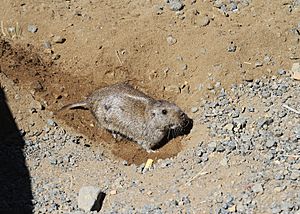Emily's tuco-tuco facts for kids
Quick facts for kids Emily's tuco-tuco |
|
|---|---|
 |
|
| Conservation status | |
| Scientific classification | |
| Genus: |
Ctenomys
|
| Species: |
emilianus
|
Emily's tuco-tuco (Ctenomys emilianus), sometimes called Emilio's tuco-tuco, is a type of rodent. It belongs to the family Ctenomyidae, which includes many different tuco-tuco species. This animal is special because it is endemic to Argentina. This means it can only be found naturally in Argentina and nowhere else in the world.
The tuco-tuco was named after Emilio Budin. He was an Argentine collector who gathered animal specimens. He worked with a famous scientist named Oldfield Thomas.
Contents
What Does Emily's Tuco-Tuco Look Like?
Emily's tuco-tuco is a small mammal. It grows to be about 26 to 30 centimeters (10 to 12 inches) long. This measurement includes its tail, which is about 7.5 to 9.3 centimeters (3 to 3.7 inches) long.
Fur Color and Markings
Its fur is usually a shiny fawn color. Sometimes it can be a pale grayish-brown. It might even have a slightly pink look. This tuco-tuco does not have any black marks on its body.
The sides of its body and its belly are whitish. This lighter color also goes down its thighs and hips. This makes a clear difference from the much browner color of its rump. Its feet and tail are also whitish. The small crest of hair on its tail has very little black color.
Where Does Emily's Tuco-Tuco Live?
Emily's tuco-tuco lives only in west-central Argentina. It is found in the Province of Neuquén. There are several separate groups of these animals in this area.
Habitat and Environment
These tuco-tucos prefer to live in sandy areas. They are often found in sand dunes. Their homes are usually at high places, around 800 meters (2,600 feet) above sea level. They dig tunnels and burrows in the sand to live and find food.
See also
 In Spanish: Tucu-tucu de las dunas para niños
In Spanish: Tucu-tucu de las dunas para niños


